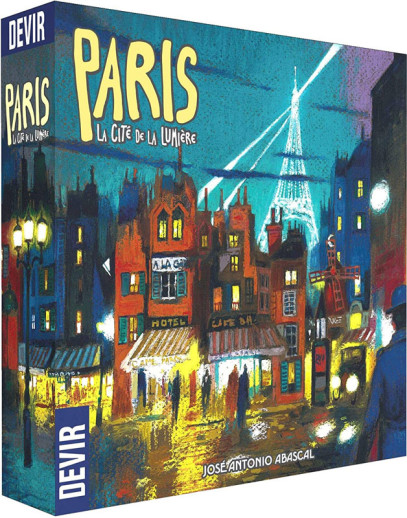We use cookies to make your experience better. To comply with the new e-Privacy directive, we need to ask for your consent to set the cookies. Learn more.
Paris: La Cite De La Lumiere Game
What can I tell you about Paris the City of Lights? Unfortunately, I have not been to Paris, but I haveplayed Paris La Cite De La Lumiere which is a wonderful, two-person strategy game. The unique thing about this game, besides its beautiful theme, is that it uses its own game box to create the streetscape of the city. The game starts with each player receiving either orange or blue cobblestone street pieces and chimney tokens with which they will build and claim their structures. There are also special actions to assist players that award extra points in the form of “postcards". These postcards are all unique and eight of these are used per game. Each player will receive four tokens in their color (orange or blue) with which they will be able to claim these postcards. The game begins with Phase 1 in which players take turns either placing a cobblestone street piece on the streetscape grid or reserving one of twelve building pieces of different shapes and sizes to use in the next phase of the game. During this phase, strategic placement of street pieces is important, as they each have a mixture of both players' colors as well as neutral colors – and some of these pieces have streetlamps. Because players will only be able to place building pieces on either their own color squares or neutral color squares, but NOT on the other player's color or a streetlight, it is important to choose building pieces carefully so that you will be able to put them on the newly emerging streetscape. Placing buildings adjacent to as many streetlamps as possible will also compound points at the end of the game. It is useful to reserve three or four building pieces during Phase 1 but not to choose too many pieces as players lose points for any unplaced buildings. Once all of the pavement pieces are placed, Phase 1 ends. In Phase 2, players take turns either placing building pieces on the streetscape or claiming one of the bonus postcards. It is important to understand which postcard actions are available and start claiming them strategically in order to maximize your point benefits based on the emerging building patterns. Phase 2 ends when no more building pieces can be placed and each player has claimed four postcard actions. The scoring parameters reward players for each building size, multiplied by its adjacent streetlights and the largest contiguous building. Next, each player loses three points for any reserved but unbuilt buildings. Finally, each player checks their claimed action postcards to see if they earn additional victory points. The player with the most points wins the game. Whether or not you are victorious, this resource is a nice, quick and challenging game that folks will want to play again and again. For ages 8+, with a 30-minute play time. ~ Marsha
Paris is a two-player board game by José Antonio Abascal infused with Parisian aesthetics by the boardgame's artist Oriol Hernández. The game is set in late 19th century Paris during the 1889 "Exposition Universelle," or world's fair, when public electricity was a hot topic. Electricity spread throughout the city, creating today's beautiful nocturnal Parisian streets and coining Paris's nickname "La Cité de la Lumiére", the city of lights.
The most well-lit buildings are admired more highly by passers-by. In the first phase, players can either place tiles or grow their reserve of buildings. The cobblestone tiles are divided into 4 random spaces (their color, their opponents' color, a streetlight or a mixed-color space where either player can build).
Then, in the second phase, players build on top of their color or the mixed spaces, in effort to position their buildings as close to as many streetlights as possible. More streetlights solicit more adoration and points. The player with the best lit buildings steals the hearts of Parisian pedestrians and wins the game.
Please also see our Logic - Games section for more excellent strategy games.
| Product Format: | Other |
|---|---|
| Brand: | Devir Games |
| Grades: | 3-AD |
| EAN/UPC: | 8436017228397 |
| Length in Inches: | 8 |
| Width in Inches: | 8 |
| Height in Inches: | 2 |
| Weight in Pounds: | 0.9813 |

